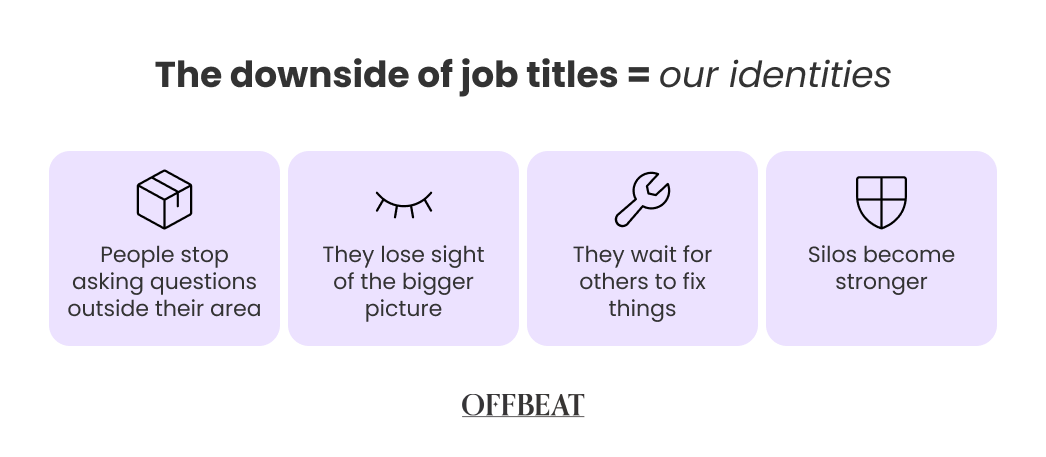Job titles are killing organizational learning
Job titles help us make sense of organizations, but when they define who we are, learning slows down.
We put people in boxes all the time. Quiet. Bold. Creative. Not a people person. But the boxes organizations love most?
Job titles.
When people begin to equate their identity with their job title, organizational learning and thinking slow down. Here's what often happens:
People stop asking questions outside their area. They focus only on what’s in their job description and avoid stepping into conversations that don’t feel like “their responsibility.”
They lose sight of the bigger picture. Decisions are made in isolation. People don’t see how their work affects others, or how small actions contribute to larger outcomes.
They wait for others to fix things. “If it’s not my job, it’s someone else’s problem.”
Silos become stronger. Departments protect their space, knowledge stays locked in roles, and opportunities for collaboration shrink.
Side note: People are always more than their job title. They might be learning to lead a team in their volunteer work, building negotiation skills through parenting, or developing creative thinking through a side project. A more integrated way of seeing people, one that acknowledges learning across all areas of life, could benefit both individuals and organizations. But that’s a story for another time.
The truth is, job titles aren’t going anywhere anytime soon. They’ve been here for so long helping individuals navigate complexity and create mental models of the organization, that it’s hard to imagine companies letting go of them en masse.
And that’s okay. The goal isn’t to eliminate job titles. It’s to loosen their grip on how people see themselves and others. To create space for curiosity, collaboration, and systems thinking, even within the structure of formal roles.
Here’s a practical breakdown of how:
– We shift mindsets
– We redesign everyday practices
– We rethink structures and systems
Shifting mindsets
Encouraging individuals and teams to see beyond their job titles and think systemically.
Ask better questions in 1:1s. Include prompts like “What do you want to contribute beyond your role?” or “Where do you see friction in the system?” to shift focus from tasks to impact.
Celebrate systemic thinking publicly. Recognize people who connect dots across departments or step outside their scope to solve broader problems.
Train managers to spot and remove box-thinking. Help people managers identify when someone is being limited by their title and coach them to think bigger.
Redesigning everyday practices
Embedding flexibility and system-awareness into daily routines and processes.
Introduce ‘outside the role’ challenges. Launch small projects where cross-functional teams solve real issues unrelated to their day-to-day responsibilities.
Make “job crafting” visible and encouraged. Showcase stories where people shaped or stretched their role, and encourage others to do the same.
Run “walk a mile” mini-exchanges. Enable short-term role shadowing or switching to build empathy and broaden understanding of the system.
Invite people into cross-functional design. Include people in redesigning processes (like onboarding or retrospectives) to help them see how the organization functions as a whole.
Changing structures and systems
Rewiring organizational scaffolding to reduce the power of titles and make space for fluidity.
Design job descriptions as living documents. Write job purposes and system interactions instead of static task lists. Leave room for the role to evolve.
Create development frameworks based on capabilities. Build career development around transferable skills (like collaboration or strategic thinking) rather than role-based ladders.
Include role evolution in performance reflections. Make role shifts, experimentation, and learning beyond the job scope part of how you measure growth.
Make cross-role moves part of the norm. Support horizontal moves, short-term assignments, and cross-functional roles as part of everyday development, not just exceptions.
Introduce internal portfolios. Encourage people to document and share their contributions across projects, not just within their role.
Of course, this isn’t a call to abandon structure or blur roles so much that chaos takes over. Nor is it an excuse to overwork people by asking them to “go beyond their job” without support or recognition.
It’s an invitation to build more flexible systems, ones that allow people to grow, contribute across boundaries, and see themselves as part of something bigger than a job title.
Because when we create space for people to think beyond their role, we also create space for learning, ownership, and change.
If you’re finding this newsletter valuable, share it with a friend and consider subscribing if you haven’t already.








